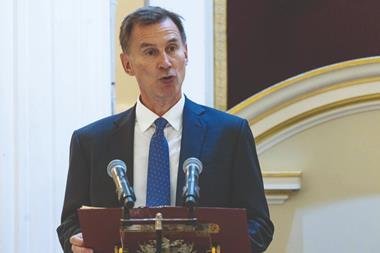UK consultants have warned that despite improvements in funding positions of defined benefit (DB) pensions schemes and bulk annuity transactions reaching record numbers, UK pension schemes have concerns over insurer capacity as they approach their endgame.
The pensions risk transfer market is “busier than ever”, according to an analysis from Barnett Waddingham, with the number and volume of deals set to hit record highs by the end of 2023.
The consultancy’s analysis confirmed that further to the £21bn of bulk annuity deals that took place in H1 2023, another £20-30bn is set to close by the end of the year. This is expected to bring the total 2023 deal value to “well over” £40bn.
Rosie Fantom, head of bulk annuities and risk transfer partner at Barnett Waddingham, said the firm expects to see a similar sized market in 2024, which has the potential to be dominated by a small number of exceptionally large trades.
She said that the challenge for insurers will be to balance the appeal of writing new business, while effectively serving the business that has already been written.
She continued: “Given the pace of the market and significant deal sizes, there is a risk that smaller transactions get lost in the noise.
“Many insurers are segmenting the market and placing increasingly complex requirements on schemes ahead of committing to delivering a quotation; as such, smaller schemes are likely to struggle without adequate preparation and support.”
Insurer capacity
Standard Life found that attracting insurer interest is the biggest concern for 20% of trustees.

Kunal Sood, managing director of DB solutions and reinsurance at Standard Life, said that bulk purchase annuities are widely considered to be the “gold standard” when it comes to de-risking.
He said: “Our research reveals that four-fifths of pension scheme trustees do expect to approach an insurer about a buy-in or buyout in the next five years.”
“With no signs of the market slowing down, schemes should remain focused on preparation and solid data, which continue to play a vital role in ensuring a smooth and efficient de-risking journey,” he noted.
Sood added that there should also be a “greater emphasis” on finding and choosing the right partner that supports schemes’ long-term objectives, especially as many trustees report concerns over a lack of engagement from sponsors and consider it a barrier to pursuing their endgame strategy.
“We are not aware of any schemes that haven’t obtained a bulk annuity quotation, and we believe there is sufficient appetite in the bulk annuity market to service all those schemes that desire insurance,” Sood said.
“For our part, we are ready to engage with DB scheme trustees to help meet their overarching endgame strategies and secure member benefits,” he concluded.
Insurer capacity is also a concern for scheme sponsors, according to Hymans Robertson, which found that almost half (48%) of DB scheme sponsors intend to buy out, but 45% of those sponsors are worried about a lack of insurer capacity or interest.
It suggested that with nearly all (95%) of those scheme sponsors intending to buy out projecting they will do so within 10 years, schemes should keep their options open for new value-creation opportunities.

Leonard Bowman, partner and head of corporate DB endgame strategy at Hymans Robertson, said that respondents were split between a full buyout (48%) and running the scheme on (44%).
He added that while buyout will be the right solution for many sponsors, there are concerns around the process with more than two in five sponsors saying they are concerned about a lack of insurer capacity or interest in their scheme (45%), accounting implications (45%), and the cost (41%).
He added: “Although there is uncertainty as to what the pension landscape will look like over the next few years, there is also opportunity in relation to new solutions coming to market and evolving government policy incentivising run-off strategies.”
However, he said that companies should also consider keeping their options open, given the potential for Mansion House reforms to open up “new value creation opportunities”, such as lowering the funding bar for extracting surplus or reducing the 35% tax charge on surplus refunds.”
Steve Webb, partner at LCP, agreed that there are “multiple endgame options” now available to schemes and new innovations are coming forward “all the time”.
He said that a strategy which seemed right when set a couple of years ago could be “missing out on important new opportunities”.
He said: “For those firmly on the path to buyout, there are still important strategic decisions to be made about timing and making sure that best value is secured.”
But for those schemes that are willing to consider running on, he pointed out that there are options including making use of DB surpluses to support DC provision, offering discretionary increases to existing DB members, as well as making sure that any eventual buyout is done at the right time and at the best price.
He said: “All of that is independent of any further reforms we may see as part of the chancellor’s ‘Mansion House’ agenda which may provide further space for seeing a pension scheme as an asset and not a burden.”
David Fairs, partner at LCP, said that targeting insurance transactions as soon as it is affordable will continue to be the right solution for some, but it will be important for pension scheme sponsors to review current plans and desired timeframes and consider the options and implications before embarking on a particular route.
Read the digital edition of IPE’s latest magazine







































No comments yet